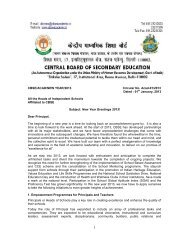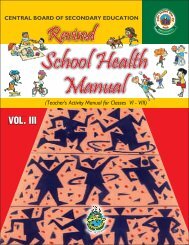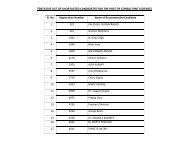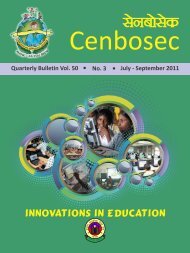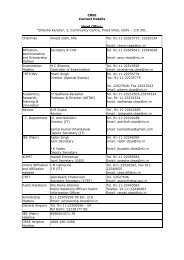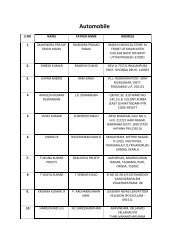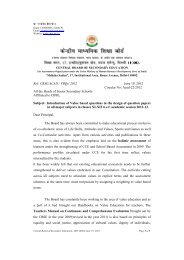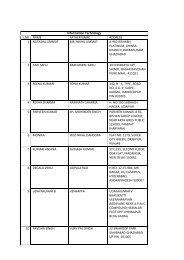- Page 3: Manual for Teachers on School Based
- Page 8 and 9: Continuous and Comprehensive Evalua
- Page 10 and 11: Continuous and Comprehensive Evalua
- Page 12 and 13: Continuous and Comprehensive Evalua
- Page 14 and 15: Continuous and Comprehensive Evalua
- Page 20 and 21: Continuous and Comprehensive Evalua
- Page 22 and 23: Continuous and Comprehensive Evalua
- Page 24 and 25: Continuous and Comprehensive Evalua
- Page 26 and 27: Continuous and Comprehensive Evalua
- Page 30 and 31: Continuous and Comprehensive Evalua
- Page 32 and 33: School Based Continuous & Comprehen
- Page 34 and 35: School Based Continuous & Comprehen
- Page 36 and 37: Chapter 3CCE in Middle SchoolLevelE
- Page 38 and 39: CCE in Middle School Level- Effecti
- Page 40 and 41: CCE in Middle School LevelII. Evalu
- Page 42 and 43: CCE in Middle School LevelIV. Forma
- Page 44 and 45: CCE in Middle School LevelPart 2: C
- Page 46 and 47: CCE in Middle School Level3(A) Co-S
- Page 48 and 49: Health StatusHeight __________ Weig
- Page 50 and 51: CCE in Middle School LevelThe Forma
- Page 52 and 53: CCE in Middle School LevelContinuou
- Page 54 and 55: Assessing Co-Scholastic Areascourte
- Page 56 and 57: Assessing Co-Scholastic AreasI. Lif
- Page 58 and 59: Assessing Co-Scholastic AreasContin
- Page 60 and 61: Assessing Co-Scholastic Areas(iii)
- Page 62 and 63: Assessing Co-Scholastic Areas4. Exh
- Page 64 and 65: Assessing Co-Scholastic AreasContin
- Page 66 and 67: Assessing Co-Scholastic Areas(ii) A
- Page 68 and 69: Assessing Co-Scholastic Areas(ii)c.
- Page 70 and 71: Assessing Co-Scholastic Areas(vii)
- Page 72 and 73: Assessing Co-Scholastic Areas9. Dis
- Page 74 and 75: Assessing Co-Scholastic Areas6. Tak
- Page 76 and 77: Assessing Co-Scholastic AreasPartic
- Page 78 and 79:
Assessing Co-Scholastic AreasGradeG
- Page 80 and 81:
Tools and Techniques of Evaluationa
- Page 82 and 83:
Tools and Techniques of Evaluation(
- Page 84 and 85:
Tools and Techniques of Evaluation(
- Page 86 and 87:
Tools and Techniques of EvaluationS
- Page 88 and 89:
Tools and Techniques of Evaluation(
- Page 90 and 91:
Tools and Techniques of EvaluationP
- Page 92 and 93:
Tools and Techniques of Evaluation(
- Page 94 and 95:
Tools and Techniques of Evaluation(
- Page 96 and 97:
Tools and Techniques of EvaluationC
- Page 98 and 99:
Tools and Techniques of Evaluation(
- Page 100 and 101:
Tools and Techniques of Evaluationo
- Page 102 and 103:
Tools and Techniques of Evaluation7
- Page 104 and 105:
Tools and Techniques of Evaluation1
- Page 106 and 107:
Implications for Schoolstransposabl
- Page 108 and 109:
Implications for SchoolsII. Assessm
- Page 110 and 111:
Implications for SchoolsA school ca
- Page 112 and 113:
Implications for SchoolsYear 2008 :
- Page 114 and 115:
Implications for SchoolsThe content
- Page 116 and 117:
Annexure 1Types ofAssessmenttools/t
- Page 118 and 119:
Annexure 1Types ofAssessmenttools/t
- Page 120 and 121:
Annexure 1Types ofAssessmenttools/t
- Page 122 and 123:
Annexure 2GlossaryGLOSSARY OF TERMS
- Page 124 and 125:
Standardised Test: It is a test whi
- Page 126 and 127:
Annexure 3aCENTRAL BOARD OF SECONDA
- Page 128 and 129:
Annexure 3athe primary level so tha
- Page 130 and 131:
Annexure 3CCENTRAL BOARD OF SECONDA
- Page 132 and 133:
Annexure 3cA. LanguagesEnglish Eval
- Page 134 and 135:
Annexure 3cEvaluation 1Specific Par
- Page 136 and 137:
Annexure 3cNAME OF THE SCHOOLACHIEV
- Page 138 and 139:
Annexure 3cB MathematicsAspects Eva
- Page 140 and 141:
Annexure 3dIt is felt that at this
- Page 142 and 143:
Annexure 3eCENTRAL BOARD OF SECONDA
- Page 144 and 145:
Annexure 3ediagnosis of gaps and di
- Page 146 and 147:
Annexure 3eTestingArea/Skill/Compet
- Page 148 and 149:
Annexure 3eContinuous and Comprehen
- Page 150 and 151:
Annexure 3eContinuous and Comprehen
- Page 152 and 153:
Annexure 3eContinuous and Comprehen
- Page 154 and 155:
Annexure 3eContinuous and Comprehen
- Page 156 and 157:
Annexure 3eContinuous and Comprehen
- Page 158 and 159:
Annexure 3eContinuous and Comprehen
- Page 160 and 161:
Annexure 3fCENTRAL BOARD Of SECONDA





